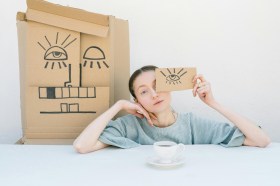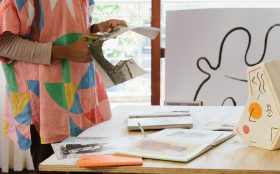By Angela Meredith
Campbell Works in Stoke Newington is a fitting venue to host Delaine Le Bas’ latest Witch Huntproject. Romany gypsies settled on Hackney Marshes at the end of the 19th century – and Irish Travellers occupied a site between Mare Street and London Fields following the 1968 Caravan Sites Act. Gypsies and travellers in Hackney again found themselves displaced once the development of the 2012 Olympics site got underway.
Delaine Le Bas is herself a Romany gypsy – her husband, artist Damien Le Bas, originates from an Irish traveller family.
Witch Huntcontinues the themes of her previous work in seeking resolution to the fear factor that merely the mention of the word ‘gypsy’ can conjure up – in 2009, Madonna was booed for speaking out in support of gays and gypsies at a concert in Romania.
Enter Campbell Works’ main hall and those not of Romany or traveller heritage immediately become the outsider. Delaine Le Bas makes her manifesto clear – a paper mural hangs across a corner, with the figure of woman standing before it, her hands tied by the fabric of her costume.
On the mural are written the articles of the Universal Declaration of Human Rights, subverted with the phrases and myths often attached to gypsies. How language portrays and betrays gypsy culture is one of Le Bas’ constant themes.
Le Bas’ work is painted, stitched, printed, collaged, embroidered, beaded, graffiti’d, dressed with flowers and feathers, pinned, mirrored, sequinned, buttoned, decked in satin and lace – and then some. The handiwork is exquisite – getting up close to appreciate the dainty stitching of a costume or the intricate draughtsmanship of a painting is crucial: and that is frequently when a tiny, almost subliminal detail illuminating the fear or prejudice gypsies endure scores a direct hit.
The objects in the show have been garnered from boot sales and charity shops and date from the 1950s onwards: mannequins decked in 1950/60s apron dresses – an altarpiece within a calico Bender tent displays celluloid dolls, plus all those knickknacks of ornaments and lampshades, kitsch toys and jewellery stands, items of cultural and religious iconography that somehow comprise the amassed fairground clutter of communal childhood memories.
(By comparison, Kirstie Allsopp’s ‘Homemade Home’ on Channel Four looks a pretty poor effort, but then the Romany and traveller communities virtually invented recycling and the car boot sale.)
Look more closely at the brilliantly coloured murals and exhibits and you will find a twisted fairytale of prejudice and pain. Pastoral scenes and mythologies are juxtaposed with questions about truth and identity – is fear of the gypsy community little more than an infant-acquired terror of the Big Bad Wolf or the Wicked Witch?
Childhood is important to Le Bas – she speaks of children bullying other children as a result of their perceived ‘otherness’ and is puzzled and hurt by it:
‘It comes from adults, because children don’t have those prejudices. People bring their perceptions of who they think we are as a people to us,’ she says.
‘I just feel that for some people, they want us to be in this time warp and this time capsule that nobody else exists within; and their argument would be that unless we’re speaking pure Romany and living by the road with horses in a wagon and living off the land, then we’re not a gypsy.
‘I don’t think that’s a correct assumption to make about people, because everyone else has progressed within the rest of society and taken on different roles, so then why is it inappropriate for us to have those aspects of life which could be quite similar to other people’s?’
Around 60 per cent of gypsies in the UK now live in houses – and most others live on settled caravan sites. But the possibility that the wider community might prefer gypsies to remain identifiable as gypsies, strikes a chord with Le Bas.
‘I think it’s fear – Witch Huntis all about anyone who is different,’ she says. ‘That’s how the prejudice comes up. If you don’t look how people think you should, then they don’t think twice about making very racist remarks. But if you look like they think you should, they wouldn’t do that.’
She is currently working on a project Black Gypsy, White Gypsy that deals further with the mass perception of gypsy identity.
Le Bas’ work is frequently referred to as ‘Outsider Art’ – a box created to contain that which is unclassifiable within accepted artistic traditions.
In the past Le Bas has said her work represents the point ‘where Outsider, Folk and Contemporary Art meet, combining a visionary, conceptual and craft approach’. But she prefers her art to exist for what it is, without categorisation.
The Witch Huntproject keeps growing, according to financial support – the show started off at the Aspex Gallery in Portsmouth and has visited Chapter Gallery in Cardiff and Context Gallery in Derry.
To find out more information about Delaine Le Bas’ Witch Hunt please visit ArtsHub’s Events page.




